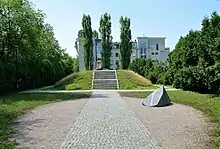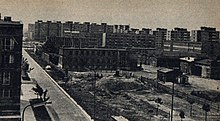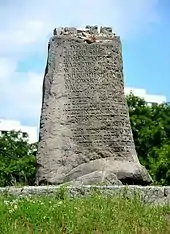Bunkier Anielewicza | |
 General view of Miła 18 memorial | |
| Location | Warsaw, Poland |
|---|---|
| Designer | Unknown (commemorative stone), Hanna Szmalenberg and Marek Moderau (obelisk) |
| Material | Granite |
| Completion date | 1946, 2006 |
The Anielewicz Bunker (Polish: Bunkier Anielewicza), also known as the Anielewicz Mount (Polish: Kopiec Anielewicza) was a headquarters and a hidden shelter of the Jewish Combat Organization (ŻOB), a Jewish resistance group in the Warsaw Ghetto in Poland during World War II.
History

The bunker at Miła 18 was constructed by a group of underworld smugglers in 1943. The ŻOB fighters arrived there after their own hideout, at 29 Miła Street, had been discovered.[1] The smugglers who had built it were helping the ŻOB as guides.
From the Stroop Report 7 May 1943:
The location of the dug-out used by the so-called select "Party Directorate" is now known. It is to be forced open tomorrow. The Jews testify that they emerge at night to get fresh air, since it is unbearable to stay permanently within the dug-outs owing to the long duration of the operation. On the average the raiding parties shoot 30 to 50 Jews each night. From these statements it was to be inferred that a considerable number of Jews are still underground in the Ghetto. Today we blew up a concrete building which we had not been able to destroy by fire. In this operation we learned that the blowing up of a building is a very lengthy process and takes an enormous amount of explosives. The best and only method for destroying the Jews therefore still remains the setting of fires.[2]
From the Stroop Report 8 May 1943:
We continued today the operation against the dug-out of the so-called select 'Party Directorate' which we had discovered yesterday, as reported in my teletype message yesterday. We succeeded in forcing open the dug-out of the Party Directorate and in catching about 60 heavily armed bandits. We succeeded in catching and liquidating Deputy Leader of the Jewish Military Organization 'ZWZ' and his so-called Chief of Staff. There were about 200 Jews in this dug-out, of whom 60 were caught and 140 were destroyed, partly owing to the strong effect of smoke-candles, and partly owing to heavy explosive charges which were laid in several places. The Jews whom we caught had already reported that innumerable Jews had been killed by the effect of the smoke-candles. The fight of the first six days was hard, but now we are able to state that we are catching those Jews and Jewesses who were the ringleaders in those days. Every time a dug-out is forced open, the Jews in it offer resistance with the arms at their disposal, light machine guns, pistols, and hand grenades. Today we again caught quite a number of Jewesses who carried loaded pistols in their bloomers, with the safety catch released. Some depositions speak of 3 to 4,000 Jews who still remain in underground holes, sewers, and dug-outs. The undersigned is resolved not to terminate the large-scale operation until the last Jew has been destroyed.[2]
On 8 May 1943, three weeks after the start of the Warsaw Ghetto Uprising, when the bunker was found out by the Nazis, there were around 300 people inside. The smugglers surrendered, but the ŻOB command, including Mordechaj Anielewicz, the leader of the uprising, stood firm. The Nazis threw tear gas into the shelter to force the occupants out. Anielewicz, his girlfriend Mira Fuchrer and many of his staff committed mass suicide by ingesting poison rather than surrender, though a few fighters who did neither managed to get out of a rear exit and later fled from the ghetto through the canals to the "Aryan side" at Prosta Street on May 10.[3]
Remembrance

In July 1945 survivors of the Jewish Underground (Among them Simcha Rotem) visited the ruins above the Command bunker.[4] The bodies of Jewish fighters were not exhumed after 1945 and the place gained the status of war memorial.
In 1946, the monument known as Anielewicz Mound, made of the rubble of Miła houses, was erected. A commemorative stone with the inscription in Polish and Yiddish was placed on top of the mound.

In 2006, a new obelisk designed by Hanna Szmalenberg and Marek Moderau was added to the memorial. The inscription in Polish, English and Yiddish reads:
Grave of the fighters of the Warsaw Ghetto Uprising built from the rubble of Miła Street, one of the liveliest streets of pre-war Jewish Warsaw. These ruins of the bunker at 18 Miła Street are the place of rest of the commanders and fighters of the Jewish Combat Organization, as well as some civilians. Among them lies Mordechaj Anielewicz, the Commander in Chief. On May 8, 1943, surrounded by the Nazis after three weeks of struggle, many perished or took their own lives, refusing to perish at the hands of their enemies. There were several hundred bunkers built in the Ghetto. Found and destroyed by the Nazis, they became graves. They could not save those who sought refuge inside them, yet they remain everlasting symbols of the Warsaw Jews’ will to live. The bunker at Miła Street was the largest in the ghetto. It is the place of rest of over one hundred fighters, only some of whom are known by name. Here they rest, buried as they fell, to remind us that the whole earth is their grave.
The names of 51 Jewish fighters whose identities have been established by historians are engraved on the front of the obelisk. Although it is often claimed that Miła 18 was the last shelter in the Ghetto to fall, this was not the case (according to Jürgen Stroop, his men took 30 "bunkers" on 12 May alone). It should be also noted that the current street numbering in Mila Street does not correspond to the wartime numbering: the memorial is nowadays at the intersection of Miła and Dubois streets while the current Miła 18 is an apartment block around 700 metres to the west.
Jewish fighters who died at Miła 18

- Chaim Akerman
- Małka Alterman
- Mordechaj Anielewicz
- Nate Bartmeser
- Heniek Bartowicz
- Franka Berman
- Tosia Berman
- Icchak Blaustein
- Melach Błones
- Berl Braude
- Icchak Chadasz
- Nesia Cukier
- Icchak Dembiński
- Józef Fass
- Efraim Fondamiński
- Towa Frenkel
- Emus Frojnd
- Mira Fuchrer
- Wolf Gold
- Miriam Hajnsdorf
- Aron Halzband
- Rut Hejman
- Mira Izbicka
- Salke Kamień
- Ziuta Klejnman
- Jaffa Lewender
- Lolek (first name only)
- Sewek Nulman
- Abraham Orwacz
- Rywka Pasamonik
- Majloch Perelman
- Aron Rajzband
- Lutek Rotblat
- Miriam Rotblat
- Jardena Rozenberg
- Salka (first name only)
- Jerzy Sarnak
- Szmuel Sobol
- Basia Sylman
- Szyja Szpancer
- Moniek Sztengel
- Szulamit Szuszkowska
- Mojsze Waksfeld
- Olek Wartowicz
- Icchak Wichter
- Arie Wilner
- Zeew Wortman
- Hirsz Wroński
- Rachelka Zylberberg
- Moszek Zylbertszajn
- Sara Żagiel
References
- ↑ J.Leociak, Spojrzenia na warszawskie getto. Ulica Miła, Dom Spotkań z Historią, Warszawa 2011, p. 26.
- 1 2 "The Stroop Report". fcit.usf.edu. Florida Center for Instructional Technology. 2005. Retrieved 15 July 2021.
- ↑ C.Lubetkin, Zagłada i powstanie, Książka i Wiedza, Warszawa 1999.
- ↑ Sztetl org Mila 18 Bunker site photograph